Dear hoteliers,
Sometimes, you have to step back and observe what’s going on around you – even if it’s not always easy, given the need to manage the various situations in your professional life on a daily basis.
However, it can be very profitable to observe the major market trends and to see how things are evolving globally.
This is precisely the subject of this article, in which I’m going to use the wonderful tool known as Google Trends to examine how the world of travel—and, more specifically, the hotel industry—is doing.
I hope you enjoy reading this article!
How does Google Trends work?
First of all, you need to understand what Google Trends is and how it works. In the past, I have often used this tool to support my statements. Some of you have told me that it’s not appropriate to use Google Trends this way.
Well, it is appropriate! Google Trends is an excellent tool if you interpret your data correctly.
In fact, the underlying concept of Google Trends focuses more on analyzing Internet user interest in a certain subject than on the number of searches. More precisely, the calculation it performs corresponds to the number of searches on a subject compared to the number of overall searches on Google over the same period.
In other words, if there were 1,000 searches in March and 500 of them were for “Mr. Dupont’s shoes” and there were 10,000 searches in April, but only 1,000 of them were for “Mr. Dupont’s shoes,” then Google Trends would show a higher score in March than it did in April.
Why? Because 50% of the people were interested in this subject in March, compared to only 10% in April.
Of course, my example is intentionally crude, the purpose being mainly to illustrate my explanations. Google never records 10 times more searches from one month to another. Over a 10-year period, though, it’s likely.
So, you have to understand what Google Trends is telling you, which is, simply put, the percentage of Google users who are interested in a certain subject at a certain time.
One last piece of information to complete this statement: Don’t read the figures in the graphs as real percentages. When Google Trends displays 100, this doesn’t mean 100% of Internet users, it means the maximum interest in a subject according to how Google Trends is calibrated. So, with Google Trends, we can’t really know what 100 actually represents.
In fact, as its name suggests, this tool should be used to study trends and not to estimate quantities.
Now let’s get to the heart of the matter….
Hotel searches worldwide
First, let’s analyze overall hotel searches on Google from 2013 to 2018:

There is a pattern that shows a slightly rising trend of interest in this subject. Note that the peaks systematically correspond to July / August and that the troughs correspond to December.
If we compare the above trend with searches related to travel in general, we can also observe a slight increase in interest over the last five years.

So far, so good. Internet users are still interested in traveling!
The five largest hotel chains
For the second part of this analysis, we will show trends based on Google searches for the five largest hotel chains in the world: Marriott, Hilton, Accor, Wyndham and Hyatt.
The purpose here is not to analyze how well-known these chains are and how often their websites are visited (figures that can be influenced by advertising, for example), but instead, the purpose is to see if Internet users tend to start with a specific hotel chain when searching for a hotel.
The figures don’t tell us much, so I finally had to expand the field of view and look as far back as 2004:
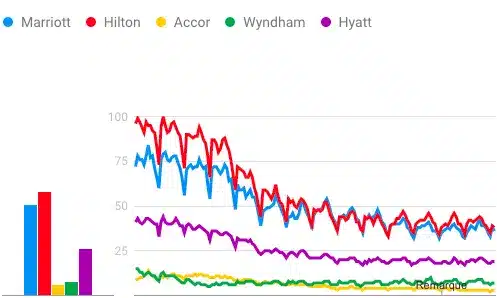
The drop in interest in all of these chains happened between 2007 and 2008.
Some other hotel chains
Now let’s use the exact same graph, but with other hotel chains.
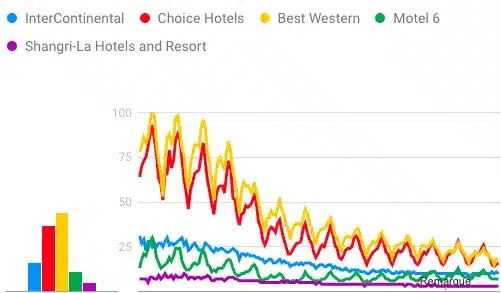
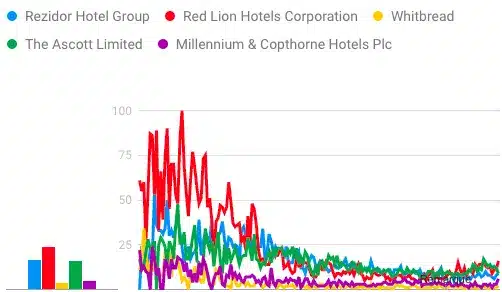
And the result is the same: between 2007 and 2008, Internet user interest in these brands dropped sharply.
The figures are so similar that you might wonder if this is just a wrong conclusion based on a tool that works on percentages and not on actual quantity. Is it possible that during those two years there was simply a sudden change in the types of Internet users (such as, younger, older, etc.) and that therefore, there was a change in their behavior? Or, could it have been a sudden increase in the number of general searches on travel? If so, this would explain the above figures.
So, let’s make use of our first graph (overall Internet user interest in travel). And this time, let’s look starting in 2004, so we have the same number of years as the graphs we used to analyze hotel chains

Indeed, we can observe a similar trend, but this drop occurred between 2005 and 2010. So yes, there has been a change in the types of Internet users and a change in the number of general searches on travel.
However, the dates and proportions don’t correspond exactly. So, there is another factor that has to be considered.
Online travel agencies
Let’s use the same graphs again, but examine online travel agencies this time:

This graph is very interesting. Even if Expedia has decreased slightly at about the same time as the decrease in interest in hotel chains, it didn’t bottom out, either. But Booking, Agoda, and TripAdvisor appeared almost out of nowhere between 2008 and 2010.
Clearly, there is a causal relationship between the drops shown above and the rise of online travel agencies.
Comparison
Once again, Google Trends displays trends in relation to unknown overall quantities. So, you can really be misled by this tool… unless you use it to compare two trends. Then the tool suddenly turns out to be a gold mine of information.
Here’s an example:
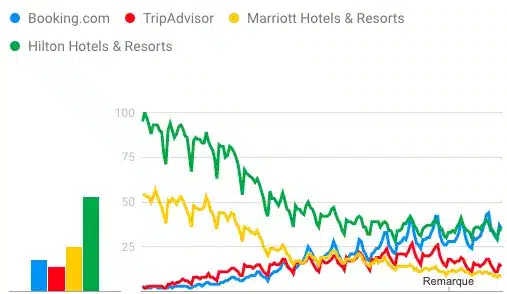
We can clearly see a decline here in the interest in Hilton and Marriott around the same time that an interest in Booking and TripAdvisor is beginning to emerge.
If you want to have a little fun making some comparisons, you can check out the tool here: https://trends.google.fr/trends/explore?cat=179&date=all&q=%2Fm%2F0yxzc1z,%2Fm%2F09py1r,%2Fm%2F09v0qh,%2Fm%2F0cmxrn
Another way to examine the data is to observe which of the above searches are currently the most common in each country.
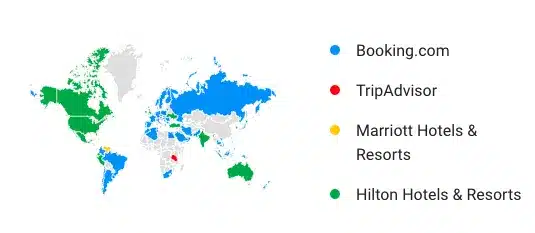
Hilton is still extremely prevalent in North America and Australia. And Booking has clearly carried off the victory in Europe and South America.
Conclusion
The market has indeed changed drastically over the past 10 years. This fact has already been noted, but the figures now support these observations.
However, the hotel chains are not yet in their death throes. They still remain important enough to maintain their leadership despite the increasing use of tools such as Booking and Expedia.
Let’s not be mistaken about it either: These trends still indicate an uncertain future for the major hotel chains. Unless they rethink their strategies quickly, they’re likely to be devoured by online booking platforms offering a wider range of hotels. But remember, this is not necessarily inevitable. The hotel chains must react quickly and effectively, because there are solutions.
The ball is now in their court. And I sincerely hope to see the hotel chains come up with real innovations soon that will allow them to “bring balance to the Force!”
Don’t hesitate to contact me by email or in the comments if you have other questions on the subject.
Thanks!
